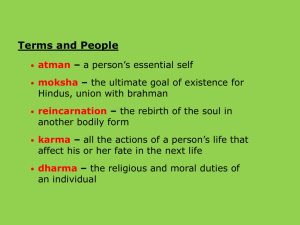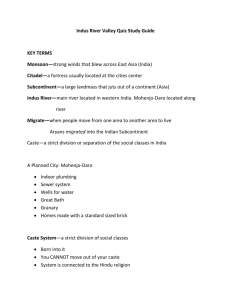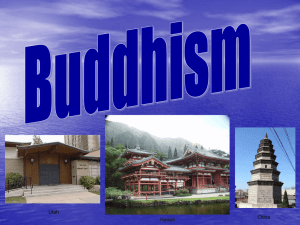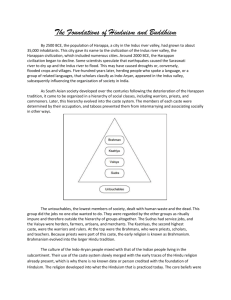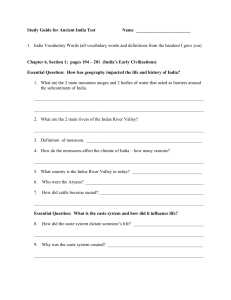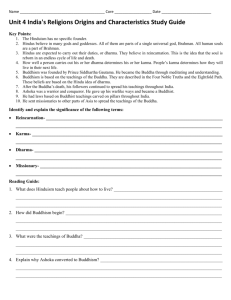Unit 3a: Ancient India - Pleasantville High School
advertisement
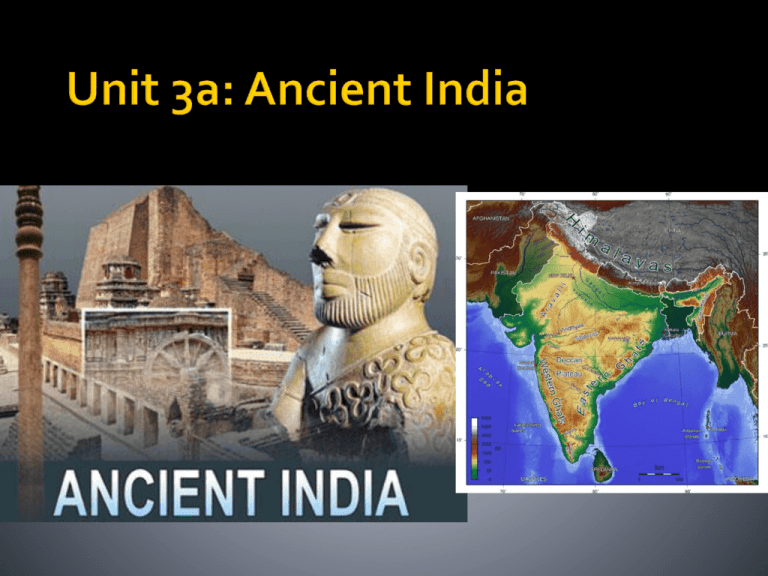
Essential Question: What were the important characteristics of the civilizations in the Indus River Valley? Warm-Up Question: Name 2 similarities between Egypt & Mesopotamian civilizations Name 2 differences The Indus River Valley (India) Class Activity: Take a diamond shaped schematic map and use the ancient India map in the blue World History textbook pg. 53 to help you fill out the schematic map What can you learn about a civilization by looking at its cities? Provide at least 3 examples. India began along the Indus River, which flooded & left behind fertile soil Seasonal monsoons caused summer rains & floods The people were well protected on the Indian subcontinent by the oceans, mountains, & deserts that surrounded the Indus River Valley 9H - Do-Now: When you think of an advanced civilization/society, what images or ideas come to mind? Make a list of 5-10 elements of an advanced civilization. Advanced cities: Two of its most famous cities were Harappa and Mohenjo-Daro Indus cities were laid out in a grid system with high walls & citadel of major buildings Harappa and Mohenjo-Daro were possible twin capitals of the civilization. Baked clay bricks were common building materials Had a complex plumbing system – sewers, drains, baths, etc. Merchants had a uniform system of weights and measures. Well organized government Urban Planning Technology: Advanced plumbing; Most houses had toilets & private bathrooms connected to underground sewer systems Standard, oven-baked bricks Making a Living by Farming and Trading Most were farmers Variety of crops: wheat, barley, melons, and dates. Others were merchants and traders Ships carried the following: cotton cloth, grain, copper, pearls, and ivory Reached the city-states of Sumer Indus valley developed their own writing system (not yet deciphered) and religious beliefs. Polytheistic Mother goddess, a source of creation, was widely honored – there was also a male god Viewed certain animals sacred: buffalo, bull, and cattle Veneration – special regard for cattle 1900 BC Indus Valley declines Crude pottery, use of writing declined, cities abandoned, populations decreased. Scholars do not know what happened, however there are various possibilities: invaders, damage to local environment, major flooding, and/or an earthquake. Nomads migrated to Central Asia Traveled through mountain passes in Northwest India Aryans Emerge in India Nomads intermarried with local peoples to form a group called Aryans Acculturation – blending of two or more cultures Combined the cultural traditions of the nomads with those of earlier Indian peoples. Left behind very little archaeological evidence Vedas – collection of hymns, chants, ritual instructions, and other religious teachings. Measured wealth in cows and bulls From Nomadic Life to Farming Settled into villages to cultivate crops and breed cattle Learned how to make tools out of iron Rajahs – Aryan tribes were led by chiefs; skilled war leader, elected to his position by an assembly of warriors. Divided society into ranks based on occupation: Early Caste system Highest group was Brahmins (priests), Kshatriyas (warriors), Vaisyas (herders, farmers, artisans, and merchants). Sudras were those who were not of Aryan heritage. This also includes: farm workers, servants, and other laborers. Specialized Workers: Indian society was divided by the “caste system” which divided people based on their purity in Hinduism Government: Little is known about Indus government other than they were ruled by kings Writing: Indus writing has not been fully translated so much of Indus life is still a mystery Writing contained about 400 symbols that were both pictograms & phonetic characters Polytheistic Worshipped gods and goddesses who embodied natural forces like the: sky, sun, storm, and fire. Indra – the god of war Varuna – god of order and creation Agni – god of fire and the messenger who communicated wishes to the gods Brahmins offered sacrifices of food and drink to the gods. Brahman – a single spiritual power that existed beyond the many gods and resided in all things Mystics – people who seek direct communion with divine forces. Epic Literature Tells About Aryan Life Sanskrit – priests used this written language to write sacred texts. Maintained a strong oral tradition – memorize and recite ancient hymns Mahabharata Tells of Warfare and Religion India’s greatest epic Bhagavad-Gita – reflects important Indian religious beliefs about the immortality of the soul and the value of performing one’s duty. Ramayana Teaches Values of Behavior Priest-poets added new morals to the tales to teach different lessons. Religion: Believed in a polytheistic religion called Hinduism Hindus believe that one’s soul is reborn until moksha is achieved (reincarnation) Moksha (enlightenment or nirvana) is the spiritual release from human form A soul’s karma (good or bad deeds) effect reincarnation Hinduism does not have one founder and no single sacred text. All Hindus share certain basic beliefs One Force Underlies Everything Major Gods include: Brahma – the creator Vishnu – the preserver Shiva – the destroyer Sacred Texts Reveal Hindu Beliefs Hindu teachings were recorded in the sacred texts of Vedas Upanishads are a section of Vedas that address mystical questions related to Hinduism Achieving Moksha Is the Goal of Life (State of perfect understanding) Atman – individual soul of a living being Brahman – the world soul that contains and unites all atmans. Moksha – union with brahman; must separate themselves from selfish desires Reincarnation – rebirth of the soul in another bodily form Karma – all actions of a person’s life that affect his or her fate in the next life. Dharma – religious and moral duties of an individual Ahimsa – nonviolence A religion that grew out of Hindu traditions Emphasizes meditation, self-denial, and an extreme form of ahimsa Aryans divided society into four groups Castes – social groups into which people are born and rarely change. Complex Rules Uphold the Caste System Closely linked to Hindu beliefs Rules governed every aspect of life Untouchables Caste Affects the Social Order Could achieve a higher state in life by faithfully fulfilling their duties of their present caste Limit social and economic progress Siddhartha Gautama – a reformer; his teachings spread across Asia to become core beliefs of Buddhism From Boy to Buddha Early life known from various religious writings and literature Born a prince Buddha – the enlightened one Following the Four Noble Truths Four Noble Truths – heart of Buddhism Eightfold Path – the “right” way of living Nirvana – union with the universe and release from the cycle of rebirth What is the fundamental cause of all suffering? Desire! Therefore, get rid of selfish desires, don’t obsess about oneself. Middle Way between desires and self-denial. By following the Eightfold Path, anyone could reach nirvana, the Buddha’s word for release from selfishness and pain. 1. Know the truth 2. Resist evil 3. Say nothing to hurt others 4. Respect life 5. Work for the good of others 6. Free your mind of evil 7. Control your thoughts 8. Practice meditation Eightfold Path Nirvana The ultimate goal of any Buddhist Escape from the cycle of rebirth. Buddhists also believe in reincarnation and that it takes many lifetimes to reach nirvana. Both religions stress nonviolence and believed in karma, dharma, and a cycle of rebirth. Buddha urged each person to seek enlightenment through meditation Buddhists rejected the caste system Monasteries grew into centers of learning Collecting the Buddha’s Teachings throughout Asia Tripitaka – three baskets of wisdom Buddhism Spreads and Divides Missionaries and traders spread Buddhism Sects – subgroups Theravada Buddhism closely follows Buddha’s original teachings Mahayana made Buddhism easier for ordinary people to follow Founded by Chandragupta Maurya in 324 BC Gained power in the Ganges Valley; conquered northern India. He controlled a well-organized bureaucracy Divided empire into 4 provinces Each province had its own royal prince (governor) Terrified of being assassinated!!! Had food tasters and never slept two nights in a row in the same bed!!!! Chandragupta’s grandson Ruled the empire at its height Converted to Buddhism, rejected violence, preached tolerance and resolved to rule by moral example. Stone pillars set up across India, offering moral advice. Built hospitals Expanded trade which led to prosperity After his death the empire started to decline 183 BC the empire falls Division and Disunity Set In 320 AD Chandra Gupta founded this new empire 335AD Samudra Gupta assumes the throne Expanded the empire with war and conquest 375AD Chandra Gupta II becomes king. Defeats Shakas to the west and negotiates peace Golden Age: time of peace and prosperity and many achievements in math and science Declined around 5th century AD with the invasion of the Huns Everyday life revolved around the rules and duties. Joint Family Structure Joint family – parents, children, and their offspring share a common dwelling. Families were patriarchal in Northern India, the father or oldest male in the family headed the household. Families were matriarchal in Southern India, mother or oldest female headed the household. Property belonged to whole family. The Family Performs Certain Duties Dowry – payment to the bridegroom; financed the weddings Role of Women Changes Over Time Shakti – a creative energy that men lacked Typical Village Structure Ran its affairs based on caste rules and traditions Village headman and council made decisions Women were once allowed to be a part of council, but as time progressed, they were restricted from doing so. Organized villagers to cooperate on vital local projects Agriculture and Trade Shape Life Farming depended on the rains brought by the summer monsoons Communication with other villages allowed the sharing of common ideas across the subcontinent. Literature Vedas, Mahabharata, Ramayana, Bhagavad Gita Architecture Stone pillars: marked events Buddha’s life Stupa: house relics of Buddha Rock chamber: house monks, place have religious ceremonies Science and Mathematics Studied astronomy: knew earth was a sphere, rotated around the sun Calendar based on the cycles of the sun, 7-day week, and division of days into hours. Used algebra Invented the decimal system, concept of zero and symbol (0) for it


